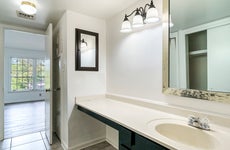6 hidden costs of home remodeling

The Bankrate promise
At Bankrate we strive to help you make smarter financial decisions. While we adhere to strict , this post may contain references to products from our partners. Here's an explanation for .
If you’re thinking about remodeling your home, you’re not alone. Annual homeowner spending on improvements and renovations has clocked double-digit growth since the pandemic, and could reach $430 billion by the second half of 2022, according to the Joint Center for Housing Studies of Harvard University. Even as the coronavirus crisis eases, part-time and hybrid work schedules are keeping many closer to home — making them decide to spruce up their residences.
Whatever project you have in mind, be advised: Its price tag isn’t limited to the materials you’ll need or the contractors you’ll hire. Home remodeling jobs tend to carry hidden costs. As you look ahead to cooking in that new state-of-the-art kitchen or turning that spare bedroom into an office, be sure to budget for these six often-overlooked expenses.
1. Securing permits
Many remodeling projects require a work permit from city or county authorities before the job commences. According to Angie Hicks, co-founder of Angi, these generally range from $424 to $2,291, with the national average being $1,330. It depends on the municipality and the nature of the work.
“Most renovations call for permits, especially if you’re updating electrical or plumbing [systems],” Hicks says. “In big cities, permits can cost up to $7,500, while in small towns they may be as low as $100.”
It may seem at times like the permitting process is an unnecessary impediment to your progress but don’t even consider skipping this step — or letting your contractor skip it (contractors are generally in charge of obtaining permits). Additional costs and fees in the form of penalties and fines will be imposed and you risk a work stoppage and invalidating insurance coverage if you don’t obtain the necessary permissions from your municipality.
Speaking of sign-offs: Many construction jobs also require post-project inspections by a municipal authority, and there could be a fee for that too, in addition to the original permit’s.
2. Installing appliances
A lot of major home appliances aren’t simply plug-in-and-go. You have to get them up and running — and that often costs money. This particularly pertains to “appliances that require complex wiring or plumbing labor, such as dishwashers” or washing machines, Hicks says. Even if you’re an advanced DIY-er, it’s often advisable to have a licensed electrician or plumber do the work. If the retailer you’re buying from offers an installation package, springing for it is not the worst idea in the world; just be sure to factor it into your final bill.
Bear in mind that the store installation only applies to the appliance. So before the appliance arrives, make sure your current HVAC, power and plumbing systems can handle it; if not, you’ll have to call in your own pro to upgrade them in advance.
“Switching a gas stove over to electric, or vice versa, bumps up appliance installation cost. Running a new gas line, adding a new circuit and breaker and refrigerators with ice makers, which need a water hookup, can all raise the cost of your renovation,” Hicks says.
3. Being dispossessed
Consider how the work might impact your routine, and for how long. If your home is enveloped in a cloud of dust during the demo or construction phases of the project, for instance, you’re not going to be able to prepare meals there, or potentially even be able to sleep there. A few weeks of eating at restaurants, or renting a space to live in, can add up quickly.
4. Encountering complications
Tearing up your home can also reveal some issues you didn’t know existed, Hicks notes, which will undoubtedly increase your costs as you pay to remedy them.
“Damage to areas not visible until the project begins; plumbing or wiring that needs to be updated to meet current building codes; termites, lead, mold, radon and other circumstances can easily move a home remodeling project beyond budget,” Hicks says. “Many contractors recommend adding an additional 10 percent to 20 percent buffer to your project’s overall cost to be prepared to deal with these types of issues.”
There may be ways to protect yourself from covering all of these “surprise” costs yourself. Construction contingency clauses in contracts can be negotiated to hold the contractor at least partially responsible for the added expense to remedy a complication, especially if it’s one that could have been avoided or anticipated.
5. Cleaning up
“Construction leaves a lot of dust and debris, so you’ll want the job to be thorough,” Hicks says. “It includes everything from ridding the walls of scuff marks and smudges to waxing floors and scrubbing windows.”
Some of these costs can also be anticipated upfront and you should make the effort to have your contractor provide a fixed price for initial demolition and debris removal costs — or at least, a price estimate for these services; you can also request a later adjustment if actual costs are less.
Finally, consider spending a bit more to have the impacted area of your home swept, vacuumed, washed and polished by a professional after all work is completed, to make it “broom clean” and fully habitable. A good housekeeping or maid service can do the job quicker and more thoroughly than you can, probably, and their price will typically not exceed a few hundred dollars — between $275 and $650., according to Hicks.
6. Expanding your homeowners insurance coverage
Your dream remodel is finished, but now, it’s time to make sure it’s protected. Since a renovation can increase the worth of your home, you might find you need to pay more in premiums to bring your coverage up to an appropriate level. Some common home improvements that can affect your homeowners insurance, both in terms of replacement values and liability, include room additions and swimming pools.
Final word on hidden costs of home remodels
It’s easy to overlook certain costs when renovating a home. And since some prices can still surprise you, even after you plan ahead, it’s always best to budget a bit extra for any home improvement project. That way, the final bill won’t destroy any joy you have in your remodeled room or spiffy new space.
Related Articles



